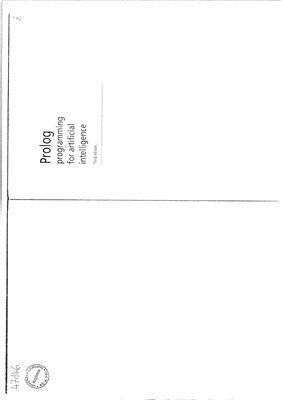The third edition of this best-selling guide to Prolog and
Artificial Intelligence has been updated to include key
developments in the field while retaining its lucid approach to
these topics. Divided into two parts, the first part of the book
introduces the programming language Prolog, while the second part
teaches Artificial Intelligence using Prolog as a tool for the
implementation of AI techniques. Prolog has its roots in logic,
however the main aim of this book is to teach Prolog as a practical
programming tool. This text therefore concentrates on the art of
using the basic mechanisms of Prolog to solve interesting problems.
The third edition has been fully revised and extended to provide an
even greater range of applications, which further enhance its value
as a self-contained guide to Prolog, AI or AI Programming for
students and professional programmers alike.
Features
· Combined approach to Prolog and AI allows flexibility for leaing and teaching
· Provides a thorough representation of AI, emphasizing practical techniques and Prolog implementations
· Prolog programs for use in projects and research are available for download on the World Wide Web.
New for this edition:
· Constraint Logic Programming
· Qualitative Reasoning
· Inductive Logic Programming
· The addition of belief networks for handling uncertainty
· A major update on machine leaing
· Additional techniques for improving program efficiency
· Meta-programming is updated to show how Prolog can be used to implement other languages (including object-oriented programming)
· A new Companion Web Site will contain further teaching materials and updates
Author:
Professor Ivan Bratko leads the AI groups in the Faculty of Computer and Information Science at both Ljubljana University and the Jozef Stefan Institute in Slovenia. He has taught Prolog world-wide as well as applying Prolog in medical expert systems, robot programming, qualitative modelling and computer chess research.
Contents
I. The Prolog Language
1. Introduction to Prolog
2. Syntax and Meaning of Prolog Programs
3. Lists, Operators, Arithmetic
4. Using Structures: Example Programs
5. Controlling Backtracking
6. Input and Output
7. More Built-in Predicates
8. Programming style and Technique
9. Operations on Data Structures
10. Advanced Tree Representations
II. Prolog in Artificial Intelligence
11. Basic Problem-Solving Strategies
12. Best-First Heuristic Search
13. Problem Decomposition and AND/OR Graphs
14. Constraint Logic Programming
15. Knowledge Representation and Expert Systems
16. An Expert System Shell
17. Planning
18. Machine Leaing
19. Inductive Logice Programming
20. Qualitative Reasoning
21. Language Processing with Grammar Rules
22. Game Playing
23. Meta-Programming
Features
· Combined approach to Prolog and AI allows flexibility for leaing and teaching
· Provides a thorough representation of AI, emphasizing practical techniques and Prolog implementations
· Prolog programs for use in projects and research are available for download on the World Wide Web.
New for this edition:
· Constraint Logic Programming
· Qualitative Reasoning
· Inductive Logic Programming
· The addition of belief networks for handling uncertainty
· A major update on machine leaing
· Additional techniques for improving program efficiency
· Meta-programming is updated to show how Prolog can be used to implement other languages (including object-oriented programming)
· A new Companion Web Site will contain further teaching materials and updates
Author:
Professor Ivan Bratko leads the AI groups in the Faculty of Computer and Information Science at both Ljubljana University and the Jozef Stefan Institute in Slovenia. He has taught Prolog world-wide as well as applying Prolog in medical expert systems, robot programming, qualitative modelling and computer chess research.
Contents
I. The Prolog Language
1. Introduction to Prolog
2. Syntax and Meaning of Prolog Programs
3. Lists, Operators, Arithmetic
4. Using Structures: Example Programs
5. Controlling Backtracking
6. Input and Output
7. More Built-in Predicates
8. Programming style and Technique
9. Operations on Data Structures
10. Advanced Tree Representations
II. Prolog in Artificial Intelligence
11. Basic Problem-Solving Strategies
12. Best-First Heuristic Search
13. Problem Decomposition and AND/OR Graphs
14. Constraint Logic Programming
15. Knowledge Representation and Expert Systems
16. An Expert System Shell
17. Planning
18. Machine Leaing
19. Inductive Logice Programming
20. Qualitative Reasoning
21. Language Processing with Grammar Rules
22. Game Playing
23. Meta-Programming

